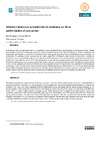Please use this identifier to cite or link to this item:
https://accedacris.ulpgc.es/jspui/handle/10553/76124
| DC Field | Value | Language |
|---|---|---|
| dc.contributor.author | Carrero Martín, José Fernando | en_US |
| dc.date.accessioned | 2020-11-30T14:17:38Z | - |
| dc.date.available | 2020-11-30T14:17:38Z | - |
| dc.date.issued | 2020 | en_US |
| dc.identifier.issn | 2340-8561 | en_US |
| dc.identifier.uri | https://accedacris.ulpgc.es/handle/10553/76124 | - |
| dc.description.abstract | El debate en torno a la traducción literal y su idoneidad a la hora de hacer frente a una traducción es ciertamente antiguo. Cuando dicho debate se aplica a la traducción audiovisual, este se encrudece todavía más. En la actualidad, es común encontrarse con comentarios posicionados en contra de la traducción literal como opción para hacer frente a modalidades como el doblaje o el subtitulado. Sin embargo, dichas aseveraciones no suelen especificar la diferencia entre técnica de traducción y método de traducción, dado que este último contiene una amplia variedad de soluciones que sí son observables y aplicables en la traducción audiovisual (véase Martínez Sierra, 2017). Para ejemplificar un caso práctico de cómo la traducción literal puede aplicarse en una forma de traducción tan creativa como la audiovisual, hemos realizado un estudio descriptivo a partir del análisis de modismos en la serie Archer, anotando qué técnicas de traducción se han empleado en hasta 35 casos dentro de la modalidad de traducción para subtitulado. A partir de este análisis, hemos descrito los datos mediante porcentajes de frecuencia (%) y los hemos representado de forma gráfica empleando diagramas. Los resultados obtenidos nos permiten observar una amplia presencia de técnicas propias del método literal, lo que nos permite reivindicar la presencia del método literal en el ámbito de la traducción audiovisual. | en_US |
| dc.description.abstract | The debate regarding the usage of literal translation has come a long way. When applied to the audio-visual translation field, it becomes even fiercer. Nowadays, it is not uncommon to find comments both in favour and against literal translation in dubbing and subtitling. That being said, these statements often not differentiate between translation method and translation technique, as the former includes a wide variety of solutions that are in fact frequently observed and applied in audio-visual translation (see Martínez Sierra, 2017). In order to offer a practical example on how literal translation can be applied to the often-creative audio-visual translation, a descriptive study has been conducted, analysing the 35 idioms found in the third season of the TV series Archer and noting which techniques have been used when translating them into Spanish. After this, we have described the data found with frequency percentages (%), using diagrams to represent them graphically. Results show that translation techniques from the literal translations method are actually quite frequent in the text, thus vindicating their usage inaudio-visual translation. | en_US |
| dc.language | spa | en_US |
| dc.relation.ispartof | LFE. Revista de Lenguas para Fines Específicos | en_US |
| dc.source | LFE. Revista de lenguas para fines específicos [eISSN 2340-8561], v. 26 (1), p. 69-83 | en_US |
| dc.subject | 570107 Lengua y literatura | en_US |
| dc.subject | 550510 Filología | en_US |
| dc.subject.other | Método de traducción | en_US |
| dc.subject.other | Técnica de traducción | en_US |
| dc.subject.other | Traducción audiovisual | en_US |
| dc.subject.other | Modismo | en_US |
| dc.subject.other | Translation method | en_US |
| dc.subject.other | Translation technique | en_US |
| dc.subject.other | Audiovisual translation | en_US |
| dc.subject.other | Idiom | en_US |
| dc.title | Método y técnica en la traducción de modismos en obras audiovisuales: el caso archer | en_US |
| dc.type | info:eu-repo/semantics/article | - |
| dc.type | Article | - |
| dc.identifier.doi | 10.20420/rlfe.2020.314 | en_US |
| dc.description.lastpage | 83 | en_US |
| dc.description.firstpage | 69 | en_US |
| dc.relation.volume | 26 | en_US |
| dc.investigacion | Artes y Humanidades | en_US |
| dc.type2 | Artículo | - |
| dc.identifier.ulpgc | Sí | en_US |
| dc.description.esci | ESCI | |
| dc.description.fecytq | Q3 | |
| dc.description.fecytpuntuacion | 27,02 | |
| dc.description.dialnetimpact | 0,0 | |
| dc.description.dialnetq | Q1 | |
| dc.description.dialnetd | D1 | |
| dc.description.erihplus | ERIH PLUS | |
| item.fulltext | Con texto completo | - |
| item.grantfulltext | open | - |
| Appears in Collections: | Artículos | |
Page view(s)
160
checked on Dec 7, 2024
Download(s)
136
checked on Dec 7, 2024
Google ScholarTM
Check
Altmetric
Share
Export metadata
Items in accedaCRIS are protected by copyright, with all rights reserved, unless otherwise indicated.
